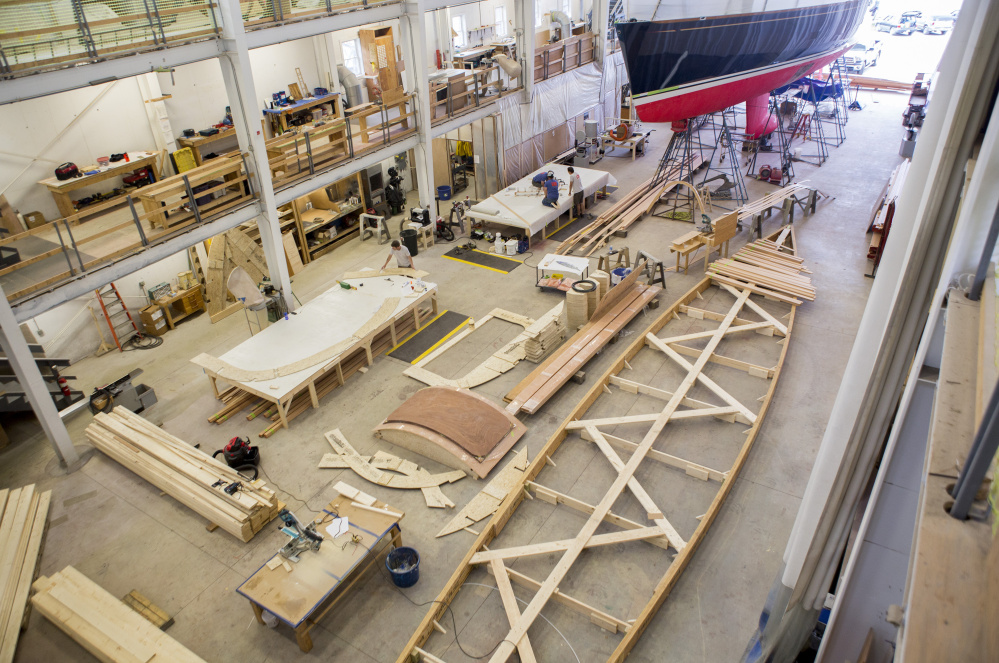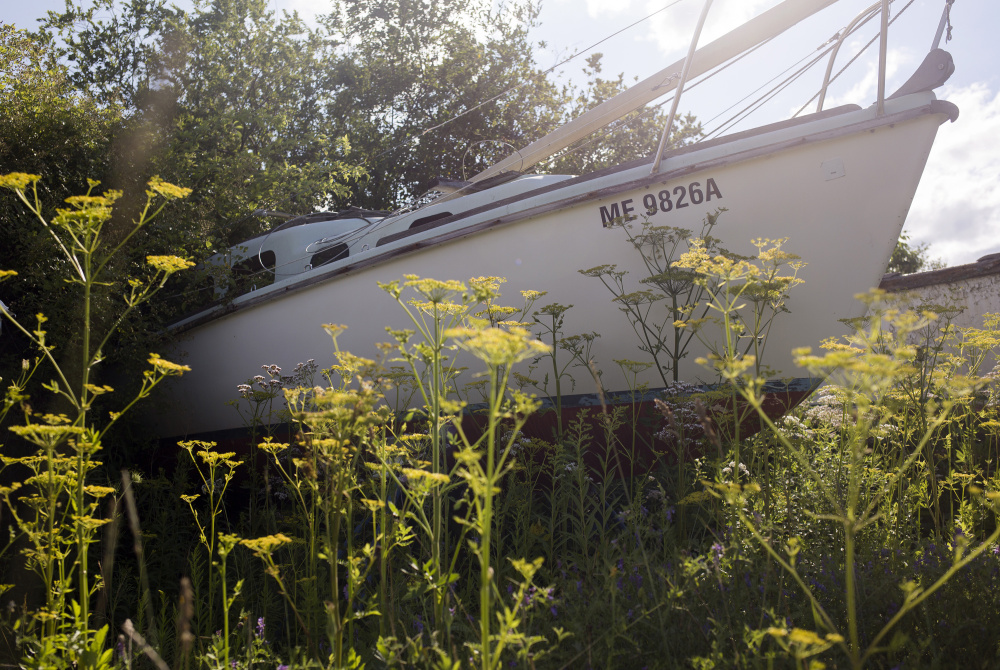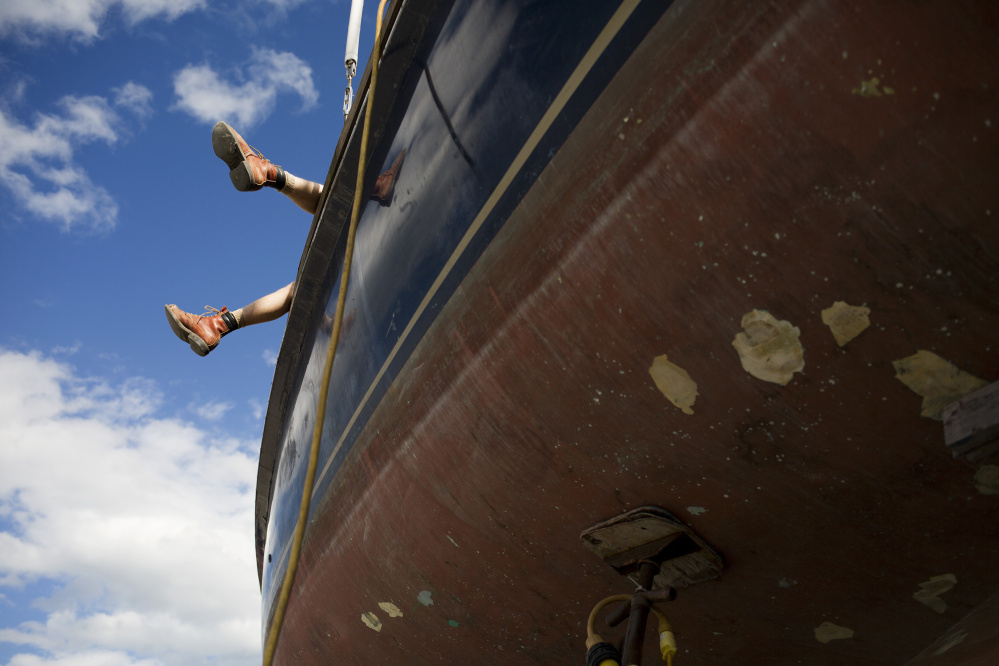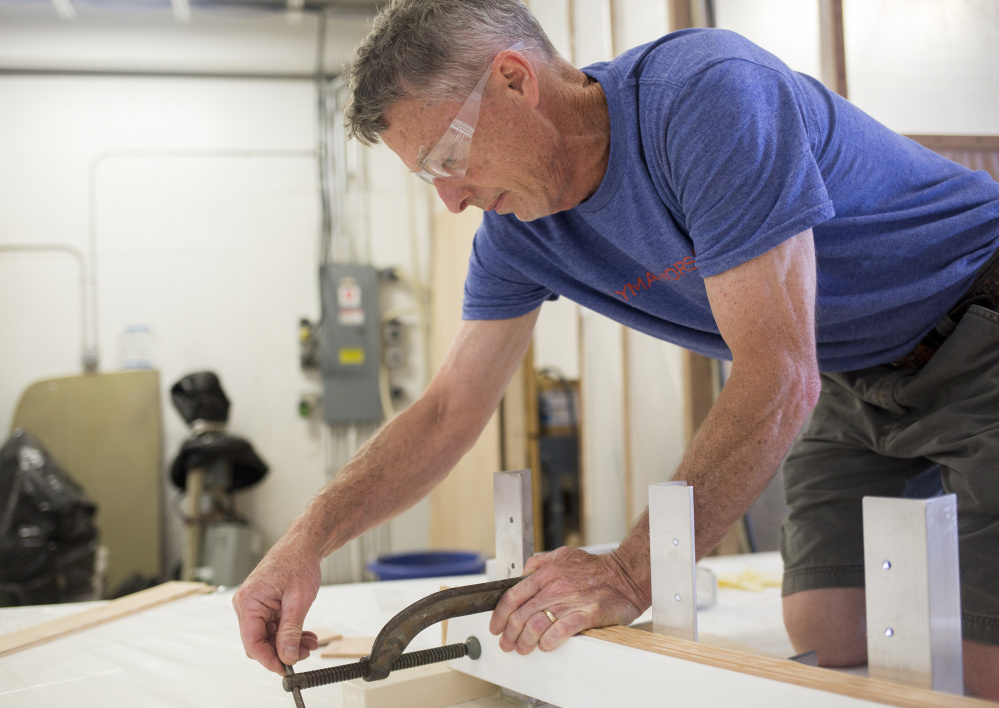Lauryn Smith had been in Maine about four years when she got the itch to buy a boat. Having grown in up in New Mexico and lived for a decade in Wyoming, she considered herself a woefully “landlocked girl.” Now here she was living in Portland, with the whole rocky coast in front of her, and she wanted access to Casco Bay.
With a budget of $5,000, the e-commerce consultant debated the choice of a used powerboat or a used sailboat. The former could be trailered, so mobility was easier, both on and off the water, but then there was the steep price of a future replacement motor ($15,000 at minimum) and fuel to consider.
“For the most part, if the wind is in your face,” she said, “you are spending money on fuel.”
Smith opted for wind power instead, picking up a 25-foot Catalina she found on the listing site Yacht World. She calls the Catalina “the Honda Civic of sailboats,” simple and sturdy, with a bare necessities toilet, or in nautical jargon, head. Ten hourlong lessons from Sail Maine in Portland and she was competent enough to set sail. She keeps track of her days on the water and proudly reports she went sailing 86 days in 2015. By mid-July this year, she’d already logged 34 days.
Smith made a very green choice. The wind was in her face many times last year, but she spent only $40 on fuel. Yet she is something of a rarity today, a new boater on the near side of 50 (she’s 37) who has chosen sail over power.
Once a staple of the Maine summer – and Maine’s boatbuilding industry – sailboats are still the stuff of bad office art and good tourism brochures, but their numbers are dwindling, along with people with the passion for this most sustainable form of recreational boating.
Unlike powerboats, they’re quiet when underway, which marine animals appreciate.
(Our increasingly noisy oceans have been shown to interfere with whale, dolphin and fish communications, creatures that use sound to find food and mates and to protect themselves.) While the Environmental Protection Agency is aiming to reduce boat motor emissions up to 90 percent through implementation of the 2008 Clean Boating Act, those engines still contribute significantly to air pollution. Then there are the spills from careless boaters, not to mention the broader environmental issue of oil production that serves purely for fun.
From Casco to Penobscot Bay, boaters and fishermen report seeing far fewer sailboats on the water than they used to. When Matt Minson, who was raised on Verona Island in a sailing family (his father is Butch Minson, who used to coach the sailing team at Maine Maritime and single-handed to Florida just a few years ago) is out on the water in his Lindenberg 28 he sees maybe 15 other sailing vessels. A decade ago, “It would be nothing to see 40 boats,” Minson said. “It is very depressing to me.”
Experts suggest a variety of reasons for the drop-off, including generational and parenting shifts and an American lifestyle that puts a premium on expediency. It’s hard to quantify what the biggest factor is. But industry statistics bear out the fact that observations of less sailboat traffic such as Minton’s are not just longing for some illusionary golden past.
“Sailboat sales are about a quarter of what they were 15 years ago,” said Thom Dammrich, the president of the National Marine Manufacturers Association.
During the recession, all sales of new boats dropped off, he said. Then as the financial crisis eased, sales of powerboats ramped back up. “They have been growing for the past five years,” Dammrich said. “In the last 12 months, they’re up 9 percent. This has been a good year.”
Not so for sailboats. Sailboat sales encompass only about 2.5 percent of all new boats.
“2009 was a dagger in the heart of sailboat building,” said Bentley Collins, vice president for marketing and sales for Sabre Yachts, the Raymond-based boat builder. The company produces plenty of powerboats but stopped making sailboats about 10 years ago when the market for them fell off. It’s not that they’d refuse to build you a new one. But the used market has more than enough supply to meet the current demand (Smith covets Sabres and saw plenty when she was shopping, but felt the Catalina would cost her less in the long run).
“For us to even attempt to compete with the used boat market would be folly,” Collins said.
MARTHA STEWART STYLE
This doesn’t mean sailboats aren’t getting built in Maine. However, Jon Johansen of the state’s boat building trade association, Maine Built Boats, can pretty much count them on one hand.
Hinckley Yachts, once known for the elegant sailboats it built on Mount Desert Island, now puts out a steady stream of powerboats. The success of its picnic boat, a sleek powerboat introduced in 1994, which counts the likes of Martha Stewart as fans (and an owner), put sailboats on the back burner. Hinckley has a few sailboats under construction this year, including a Bermuda 50, an updated model of one of its classics, but for years the company had virtually shut down its sailboat division.
At Lyman-Morse in Thomaston, boat builders are working on a 65-foot cold molded sailboat (a fiberglass skin over wood) for a private client. That sailboat, the Anna, will take a year and a half to complete.
“We’re lucky to have one build,” company president Drew Lyman said, referring to sailboats. “A lot of times, it is more service work.”
Their other projects this year include two power boats. Lyman-Morse also has a 70-foot sailboat that remains unfinished; the client they were building for “pretty much lost all their money” in the downturn, he said. As a company, Lyman-Morse has a dedication to green boatbuilding; nine years ago they constructed an energy-efficient, solar-equipped service building, where they build and repair boats in their Thomaston yard. The yacht builders used to divide their business about half and half between sail and powerboats, but that’s no longer the case (recently they diversified and got into the luxury – and green – hotel construction business, building 250 Main in Rockland, which bills itself as “a luxury yacht on Main Street”). It’s not that their sailboat building business has gone to China or other countries, Lyman said. Again, it’s just a matter of dropping demand in the U.S.
Not all of Maine’s boatbuilders have made the shift from sail to predominately power. There are small shops, boutique builders, scattered here and there. In 2015, the vaunted Brooklin Boat Yard, known for its wooden sailboats, which Johanson points out are the greenest boats to build, launched a spectacular 74-foot daysailer, Foggy, built for Frank Gehry, based on the famed architect’s own designs. But at other yards, staff is no longer on site who are trained to build sailboats. Not that the skills can’t be relearned when it comes to fiberglass production.
“You can teach anybody to lay fiberglass out,” Johanson said. “But putting a plank on a boat and planning that down? That takes talent.”
JUMP ABOARD
In many ways, this is a perfect time to do as Smith has done and buy a cheap used sailboat. They are everywhere, experts say, and they are great deals. Smith’s $5,000 got her a boat plus six life jackets, a new radio, GPS, everything she needs to be safe. “All I needed to buy were cupholders,” she said.
“I could have a million sailboats right now, for free or less,” said Michael Chasse, who founded his Freeport business, Northeast Sailboat Rescue, 12 years ago. He’s been buying abandoned sailboats from boatyards around the state, restoring and selling them. Back when he started Northeast Sailboat Rescue, he said he could sell 200 boats a year. So far in 2016, he’s sold none. (He’s planning on retiring soon and moving to some good-sized Maine lake. To sail.)
“I know boatyards where you can say, ‘How much is that sailboat there?’ and they’d probably say, ‘Take it.’ ” Johanson said. “If there is a sailboat still under cover, that means they can’t get rid of it.”
Absolutely true, agreed Celia Knight of Knight Marine Service in Rockland. “We have a ton of them,” she sighed. “You will get people coming through, walking through the yard and they will say ‘Do you have any cheap sailboats?’ I say, ‘Hey, just look at them.’ I will sell some of them for like $500 or $1,000. Sometimes it works out.”
And sometimes it doesn’t. And that’s when she has the abandoned boats hauled away to an off-site lot she calls “the boat graveyard.” An unmaintained boat exposed to the elements deteriorates rapidly, and eventually it is worthless. While fiberglass lasts a long time, it still requires upkeep. Knight said some of the boats are owned by people who can’t afford to pay their storage fees or maintenance and are too embarrassed even to take Knight Marine’s phone calls. She offers some carcasses to the fire department for training exercises, but it’s too hazardous for them to handle burning fiberglass. (Fiberglass is so complicated to dispose of that it regularly inspires how-to threads on boat-related online forums, although Chasse believes a market could and should be developed for recycling it; “It is a wonderful, inert subject.”)
“It makes it really hard on us,” Knight said. “They take up valuable jack stands. It is becoming more and more of a problem.”
It’s not just money that is an issue, either. “Fifty percent of them I would say the owners got really old or died. They got too elderly to use the boat and care for it.”
Those who purchase new boats tend to be baby boomers, according to Dammrich, of the National Marine Manufacturers Association. As that population ages, their interest in sailing declines.
“They moved to trawlers or powerboats because they love being out on the water, but they can’t do the physical part anymore,” he said. Putting up the sails, cranking the winches, being on constant alert.
“The challenge for sailing has been and continues to be bringing young people into sailing,” Dammrich said.
SAIL MAINE, PLEASE
That’s precisely what organizations like Sail Maine in Portland are trying to do, offering courses for young people and holding fundraisers to raise money for scholarships. Alex Agnew, founder of Tall Ships Portland, the group that brought El Galleon and other tall ships to Portland last summer, has been instrumental in arranging a summer program with the brigantine Fritha to take Maine students for five-day cruises on the Fritha from Portland to Fairhaven, Massachusetts. (Spots are still available for children aged 13 to 18 on the August trips.)
It can be an uphill battle though, getting young people into sailboats. “I try to give them away to kids,” said Michael Chasse. “You know what it is? They are not interested in going outside. Unless it is to play Pokemon Go.”
Chasse tells a story about selling a sailboat to a pair of 19 year olds and then having them return the next year, begging him to buy it back. They were daunted by ownership and the skills it required.
That’s a common problem, whatever the age.
“I think people saw it as a thing where it was challenging to be a good sailor,” Johanson said. “It is not difficult. But it is a lot more than turning the key and hitting the switch and going.”
Dammrich searches for politic words; after all, he is the president of a national trade association devoted to all things boats.
“I love being on a sailboat,” he said. “I think sailing is a fantastic way to be on the water. I just haven’t had time to learn to sail.”
TIME … IS IT ON YOUR SIDE?
Time is an enormous factor in the decline of this elegantly sustainable hobby. Even at its fastest, sailing isn’t likely to look alluring to generations raised on smartphones and video games.
“It looks like it is very slow-paced,” admits Matt Minson. He organizes weekly races through the Centerboard Yacht Club in South Portland. “You can be going 10 miles an hour and feel like you are about to die. But most people don’t know that. They see people out there and think they are going slow. But it is quite exciting.”
When Drew Lyman was a kid, a month of cruising with his family was the norm. Heading up a boatyard, he doesn’t lack for sailboats. But now that he is raising his own family, he feels lucky to find two days together to go sailing with his own children, who are 3 and 5.
“Americans don’t take a lot of vacation time,” he said. “It is hard for my generation to even get out… I just don’t think the younger generation is latching on to that kind of life.”
Today’s family time is simply different, said Collins of Sabre Yachts.
“I think what has happened to sailing is what has happened to so many things,” Collins said. Namely over-scheduled kids and their parental chauffeurs. “School athletics don’t just get done on Wednesday evening anymore.”
He knows. He’s got grandsons. Sailing is a wonderful pastime, Collins said. But that’s not what he does with his grandkids. He turns a key. They go fast. They see more stuff.
“I don’t sail anymore,” he said. “I’m strictly a power boater myself.”
There will always be loyalists, though. And innovators.
Take Alex Agnew, who publishes Ocean Navigator magazine (Tall Ships Portland is something he does in his spare time). About 15 years ago, he joined his first boat partnership, essentially a time share for sailboats that allows partners to share in the upkeep.
“I thought it would be great to have an affordable way that didn’t put too much burden on family time to be involved in an ocean-going voyage,” Agnew said. He’s made a trans- Atlantic crossing and competed in nine races to Bermuda since. He’s also found partners for other new (used) boats since and is part-owner of four sailboats. Annual shares in one of those boats costs about $3,000. “It has been a perfect solution. It has been inexpensive and fun, and I never work on the boat by myself. And when there is a repair bill, I only have to pay a quarter of it.”
It can be frustrating fighting against a tide that has seemed to turn against sailing. But he believes the key is getting people out for that first sail, baiting the hook as it were.
“That’s going to be the future of the sport,” Agnew said. “We are going to have to invite them along.”
Send questions/comments to the editors.








Success. Please wait for the page to reload. If the page does not reload within 5 seconds, please refresh the page.
Enter your email and password to access comments.
Hi, to comment on stories you must . This profile is in addition to your subscription and website login.
Already have a commenting profile? .
Invalid username/password.
Please check your email to confirm and complete your registration.
Only subscribers are eligible to post comments. Please subscribe or login first for digital access. Here’s why.
Use the form below to reset your password. When you've submitted your account email, we will send an email with a reset code.